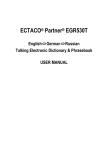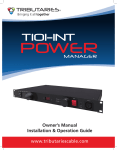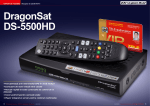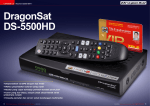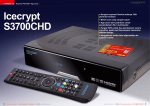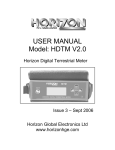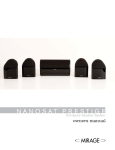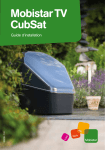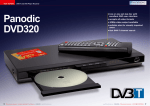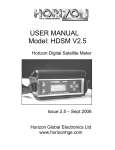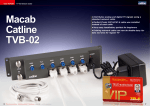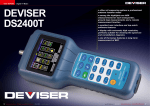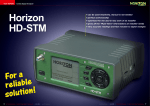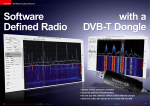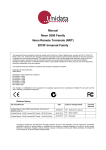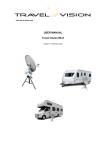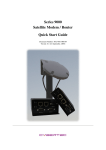Download Horizon Nano-S2 - TELE
Transcript
Тест-обзор DVB-S2 Анализатор сигнала Horizon Nano-S2 •Не требует собственного источника питания •Чрезвычайно прост в использовании •Отражает качество и уровень сигнала •Оптимизирован для измерения четырех спутниковых позиций •Быстрая скорость реакции 24 TELE-audiovision International — The World‘s Largest Digital TV Trade Magazine — 03-04/2013 — www.TELE-audiovision.com www.TELE-audiovision.com — 03-04/2013 — TELE-audiovision International — 全球发行量最大的数字电视杂志 25 TEST REPORT DVB-S2 Signal Analyzer Small and Very Practical The Horizon Nano-S2 is a very special device! It’s a signal analyzer that a) truly focuses on the essentials and b) is incredibly easy to use. We introduced the previous model, the NanoSat for DVB-S measurements, in TELE-satellite 12-01/2010. The Nano-S2 is designed for DVB-S2. Because of the lack of a power supply (there’s no rechargeable battery and no power cord), it weighs a mere 250 grams (just over ½ pound). The Nano-S2 feels small and comes with an LCD display that is merely 5.5 x 3 cm (128 x 64 pix- els) in size. The display can easily be seen even in direct sunlight and it also comes with background illumination. is perfectly equipped for the speedy installation of a satellite system. It actually is easier to use for daily antenna installations! There’s only one button on the top side along with a USB port and two “F” jacks to connect the NanoS2 to the reception system. Naturally, we here in the test center wondered if it would have made sense to include more buttons and additional connections. The obvious answer to this question turned out to be ‘no’. The Nano-S2 along with its logical operational structure and its powerful tuner The question remains then, how does the NanoS2 get its power when there are no power connections at all? Horizon answered this question very ingeniously in that the analyzer very simply draws on the satellite receiver or the active multiswitch. What might sound complicated at first is in reality quite simple: a satellite system is always put together in such a way that a coaxial cable runs from the receiver or a multiswitch to the LNB. 03-04/2013 HORIZON Nano-S2 Very easy to use signal analyzer for quick installation of satellite antennas for HDTV reception. www.TELE-audiovision.com/13/03/horizon 26 TELE-audiovision International — The World‘s Largest Digital TV Trade Magazine — 03-04/2013 — www.TELE-audiovision.com This cable carries the selected polarization voltage (13V or 18V) to the LNB. This cable is therefore connected to the right-side “F” connector of the Nano-S2 thereby receiving the required voltage. The second “F” jack is connected to the LNB using the included coax cable. This guarantees that on the one hand the analyzer can directly process the LNB signals and on the other hand the analyzer gets the power it needs. Also included in the package by Horizon is a protective cover as well as a USB cable to program the analyzer’s internal memory. A carrying strap to make it easier to work with the Nano-S2 rounds out the included accessories. For those instances when a receiver or 1 2 3 ■ TELE-satellite editor Thomas Haring aligning a 90 cm antenna with the Horizon Nano-S2 4 5 6 7 8 9 10 11 1. The Horizon Nano-S2 in programming mode 2. The selected satellite is shown in the upper left, underneath is the RF level. The antenna is moved until the analyzer recognizes the satellite 3. Once the desired satellite has been found, the MER for finetuning appears alongside the RF level 4. In just a short time we located HISPASAT 30.0° West from our location with our 90 cm antenna 5. THOR-5 0.8° West 6. EUTELSAT-16A 16° East 7. HOTBIRD 13° East 8. EUTELSAT-9A 9° East 9. The Nano-S2 is recognized by Windows as a serial port in Device Manager 10. With the help of a small tool new firmware and satellite lists can be uploaded to the Nano-S2 11. The download only takes a few seconds multiswitch is not available to supply power and the analyzer still needs to be used, Horizon also provides a battery case that can hold a total of 10 AA 1.5V batteries that could then be connected to the input “F” connector to supply the necessary power to the analyzer. As soon as the cabling is correctly taken care of, simply pushing and holding down the large button on the top side of the Nano-S2 is all that’s needed to turn it on. Next the same button is pressed again, only this time it’s pressed momentarily to select the desired satellite from the preprogrammed list. These lists consist of up to four satellite entries and are available for download from Horizon’s website (www.horizonhge. com) for different regions of the world. We’ll explain how this works shortly, but for now it’s time to test its reception capabilities. The preprogrammed sat- ellite list in our test Nano-S2 encompassed two positions for ASTRA 28.2° east (for ASTRA 1N and for ASTRA 2B), HOTBIRD 13° east as well as ASTRA 1 19.2° east. We connected the nano-S2 to our antenna on the roof and loosened the mounting screws. Once the desired satellite was selected on the analyzer’s display, in our case it was HOTBIRD at 13° east, we started aligning the antenna. First the antenna 28 TELE-audiovision International — The World‘s Largest Digital TV Trade Magazine — 03-04/2013 — www.TELE-audiovision.com was pointed exactly south; for our location that roughly represents the 16° east position. To find your local coordinates you can either use a device with a GPS receiver (SmartPhone, etc.) or you can have a look at the numerous lists available on the Internet and search for your www.TELE-audiovision.com — 03-04/2013 — TELE-audiovision International — 全球发行量最大的数字电视杂志 29 coordinates there. We recommend www.dishpointer. com A look at the Nano-S2 reveals an RF value display (signal level) in dBµV. Now adjust the elevation of the antenna, that is, adjust the antenna up or down, until the highest signal level is reached on the display. Next adjust the antenna in the azimuth direction, left or right, until the desired satellite has been found. Keep in mind though, that if the desired satellite is located a fair distance away from the southern point (in the southern hemisphere it would be the northern point), the elevation of the antenna would need to be readjusted. You’ll see how much better the RF signal level will then be. Once the Nano-S2 has identified the desired satellite, the message ‘Found’ appears in the display, an acoustical tone activates and a second bar graph for the MER (in dB) appears. To put it in simpler terms, the RF bar graph represents the signal level while the MER (Modulation Error Rate) represents the signal quality. Now simply finely adjust the antenna position in all four directions until the RF level and MER are at their maximum levels. Slowly tighten the mounting screws on the antenna. Lastly, it’s recommended to adjust the skew angle (the rotation of the LNB). For each position that is to be received, the LNB should be rotated clockwise or counterclockwise. The Nano-S2 can once again be helpful here: the LNB is rotated until the RF level and MER are at new maximums. In just a very short time we managed to perfectly align our 90 cm antenna first to HOTBIRD 13° east, then to TURKSAT 42° east, HISPASAT 30° west, THOR 5 0.8° west, EUTELSAT-5A 5° west, EUTELSAT-8A 8° west as well as EUTELSAT-12A 12.5° west. Additional control measurements using a professional signal analyzer confirmed the outstand- 1 3 5 2 4 6 3. EUTELSAT-8A 8° West (DVB-S2) 4. Comparison measurement of EUTELSAT-8A 8° West (DVB-S2) 5. TURKSAT 42° East 6. Comparison measurement of TURKSAT 42° East 1. EUTELSAT 5A 5° West 2. Comparison measurement of EUTELSAT-5A 5° West 30 TELE-audiovision International — The World‘s Largest Digital TV Trade Magazine — 03-04/2013 — www.TELE-audiovision.com ing capabilities of the little Nano-S2. We also liked that the measured MER and RF values were similar to those obtained with the professional analyzer. This speaks volumes for the quality of Horizon’s built-in tuner. As the Nano-S2 name suggests, Horizon’s new signal analyzer can receive not only DVB-S signals, but DVB-S2 signals as well. This was confirmed on EUTELSAT-8A 8° west where the frequency 11131H in DVBS2 8PSK was correctly processed. Even DVB-S2 QPSK signals (for example, on HOTBIRD 13° east) were processed effortlessly. One of the most important criteria for any signal analyzer would be its reaction time, that is, the time it needs to read and process a transponder. This would actually determine whether or not an analyzer is compatible for everyday use. If it would take, for example, five seconds to read and process a satellite position, you would have in all likelihood already moved the antenna to a new position and passed the desired satellite. But, don’t worry; the NanoS2 is light years ahead of five seconds; in our tests only about one second was needed to identify a satellite. And it didn’t matter if the antenna was moved quickly from east to west and only had access to the signal for a very short time. You’re probably grumbling to yourself right now: how was it possible to measure so many satellites when the preprogrammed list only has four entries? Very simple; Horizon currently has five satellite packages available for download with the most popular satellites in a region. Not only that, Horizon’s worldwide distribution partners will undoubtedly expand on these lists and adapt them to their regions so that every user will be able to find the entries that they need. How do you get these satellite lists into the Nano-S2? In order to add new lists or update the firmware in the analyzer, it must be connected to a PC using the included USB cable. Our test PC with Windows 7 automatically recognized the drivers that were needed and downloaded them from the Internet. If necessary, the matching drivers for all Windows versions starting with XP can also be downloaded directly from Horizon’s home page. native to align antennas at little cost. The Nano-S2 focuses on the absolute necessities resulting in intuitive and simple operation. The user manual is wellwritten and is a good source of information even for half-way experienced users but is hardly necessary. Even the Nano-S2’s technical specifications made the adrenaline flow as did its DVB-S2 reception. The excellent tuner and the speedy signal recognition topped it all off. Expert Opinion + Extremely light and easy to use. Very precise measurements and quick tuner reactions to signal changes. Designed for DVB-S2 use. Can be used immediately thanks to the preprogrammed satellite lists. – None Regardless if it’s a firmware update or a new satellite list, Horizon makes every update available in the form of an .exe file so that the user does not need to first load any download tools and then open up Firmware or Settings files. Simply start the .exe file and then click on the ‘Transfer’ button. The program will then create a connection to the Nano-S2 and transfer the desired content. This all functioned perfectly in our tests but we really didn’t expect anything less from Horizon. Thomas Haring TELE-satellite Test Center Austria TECHNICAL DATA Manufacturer Horizon Global Electronics Ltd, First Floor Office Allen House, Edinburgh Way, Harlow, Essex CM20 2HJ, United Kingdom Tel.+44-1279-417005 [email protected] ModelNano-S2 Function Digital Satellite Meter for Input frequency 950 - 2150 MHz and Signals DVB-S2 compatibleyes Modulations QPSK, Display 128 x 64 Pixel RF-Input 2x F-Type QPSK, 8PSK USB Portyes Power supply via Receiver or 10 x 1.5V AA Batteries More about this company www.TELE-audiovision.com/13/01/horizon.pdf All in all, the Horizon Nano-S2 is an excellent alter- HORIZON Nano-S2 Satellite Packs ASTRA Package East Package West Package UK Package Motorized Package ASTRA 2 (B) 28.2° East EUTELSAT 16A 16° East THOR-5 0.8° West ASTRA 2B 28.2° East TURKSAT 42° East ASTRA 3 23.5° East HOTBIRD 13° East EUTELSAT-5A 5° West ASTRA 1N 28.2° East ASTRA 19.2° East ASTRA 1 19.2° East EUTELSAT 9A 9° East EUTELSAT-8A 8° West ASTRA 1 19.2° East THOR-5 0.8° West ASTRA 4 4.8° East EUTELSAT 7A 7° East EUTELSAT-12A 12° West HOTBIRD 13° East HISPASAT 30° West 32 TELE-audiovision International — The World‘s Largest Digital TV Trade Magazine — 03-04/2013 — www.TELE-audiovision.com





